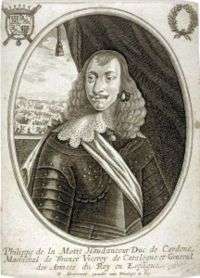Philippe de La Mothe-Houdancourt

Philippe, comte de la Mothe-Houdancourt (1605 – March 24, 1657), Duke of Cardona, was French Viceroy of Catalonia and a Marshal of France who fought in the Thirty Years' War.
Biography
Philippe de la Mothe-Houdancourt was one of 12 children of Philippe (1558-1652), Seigneur de La Mothe-Houdancourt, de Sacy et de Rucoin, and his third wife (14/02/1594), Louise Charles du Plessis-Picquet.
Since 1622 he fought in the Chevau-légers against the Huguenots and was present at the Siege of La Rochelle and the defeat of the English in the Siege of Saint-Martin-de-Ré (1627).
He then fought in the War of the Mantuan Succession and at the taking of Pinerolo in 1630, and the battle of Carignano bridge, where he was wounded. On September 1, 1632 he fought in the Battle of Castelnaudary against Henri II de Montmorency. In the same year he was made governor of Bellegarde.
At the outbreak of the Franco-Spanish War (1635) he fought at the head of his own infantry regiment in the Siege of Nancy, the Battle of Les Avins (May 20, 1635), the Siege of Leuven and the taking of the Schenk-fortress. In 1636 he defended Saint-Jean-de-Losne against Charles IV, Duke of Lorraine and general Matthias Gallas. The next years he fought several battles in Germany at the head of his own Army Corps under Henri II d'Orléans, Duke of Longueville.
As lieutenant general he was sent to Piedmont to temporary take command of the army after the death of Louis, cardinal de La Valette, waiting the arrival of Henri de Lorraine, count of Harcourt. Here La Mothe-Houdancourt distinguishes himself in taking Chieri and defeating the Spanish in the Battle of Casale and the Siege of Turin (1640) against Diego Felipez de Guzmán, Marquis of Leganés.
In 1641 he was sent to Catalonia at the head of the French Army to support the Catalan Revolt. After some initial victories he besieges Tarragona, but the city can be supplied by the Spanish over sea and he was forced to withdraw.
In September he takes the castle of Tamarite in Aragon, returns to Tarragona and lifts the siege of Almenar by the Spanish in November.
In 1642, La Mothe won the important Battle of Montmeló on March 28 capturing a Spanish force of 3.600 men. For this victory he is made a Marshal of France on April 2, Viceroy of Catalonia on June 25 after the dismissal of Urbain de Maillé-Brézé and Duke of Cardona in October.
On October 7, he obtained his most important victory, the Battle of Lleida, against Diego Felipez de Guzmán, Marquis of Leganés.
By 1644 the balance was shifting in favor of the Spanish. They besieged Lleida again, and when La Mothe tried to lift the siege though seriously outnumbered, he lost the Second Battle of Lleida (1644).
For this defeat, he was charged with treason and locked up for 4 years in the Pierre-Encise castle. Bitter by this experience he supported the claims of the Fronde and was for this relieved of command of his troops.
In 1651 he was rehabilitated and reinstated as Viceroy of Catalonia, replacing Louis II de Bourbon-Vendôme to save the desperated situation there.
He breaks through the Spanish siege of Barcelona and defended the city for several months, but was forced to surrender on October 13, 1652.
Now Catalonia was definitively lost for France and Marshal de La Mothe withdrew from active service, spending the last years of his life on his domain at Fayel.
Marriage and children
He married in 1650 with Louise de Prie (1624-1709), Marchioness of Toucy, and had 3 daughters :
- Françoise Angélique (1650-1711), married Louis Victor d'Aumont, Duke of Aumont;
- Charlotte Éléonore Madeleine (1651-1744), Duchess of Ventadour by her marriage with Louis-Charles de Lévis, governess of Louis XV and his children, credited with saving Louis XV from the ministrations of the royal doctors when he was ill as a child;
- Marie Isabelle Angélique (or Marie Gabrielle Angélique) (1654-1726), married Henri François de Saint Nectaire, Duke of La Ferté-Senneterre.
Sources
- Lacour, Louis (1859). "La Mothe-Houdancourt (Philippe, comte de)", vol. 29, columns 247–250, in Nouvelle biographie générale, edited by Ferdinand Hoefer.
|